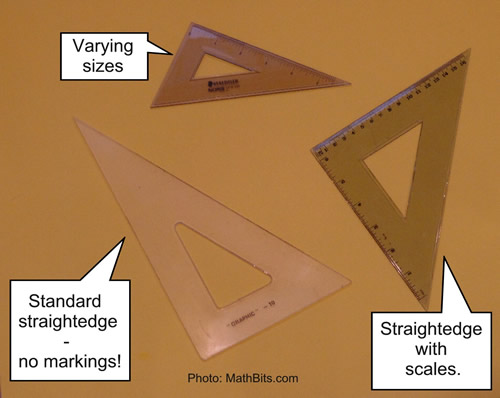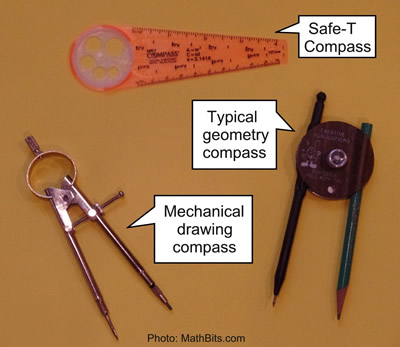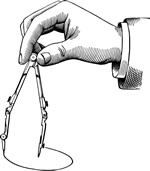|
In geometry, formal constructions utilize only two tools:
• the straightedge (an unmarked ruler)
• the compass |
|
Taking measurements using a protractor or a ruler is never considered to be part of a geometric construction. Also, freehand drawing is never part of a geometric construction, except for labeling of the finished drawing. |
|

1. The straight edge is used for drawing lines, segments and rays.
(NOTE: If using a "ruler", never use the markings on the ruler to take measurements within the construction.)
2. The compass is used to create circles and arcs. The compass can be used to determine and copy distances, or lengths.
3. When making a construction, ALWAYS LEAVE ALL CONSTRUTION MARKS on the construction drawing.
4. No part of a construction is to be done by drawing "freehand".

A straightedge is a tool used for drawing straight lines, rays, and segments.
While a straightedge is typically a clear plastic tool in the shape of a triangle and devoid of markings, it technically can be any item which will guide your pencil when drawing a straight line. A ruler may be used as a straightedge as long as the markings on the ruler are ignored.


A compass is used for drawing circles and arcs, and for measuring distances. While this tool comes in a variety of styles, most compasses have two legs, one with a spike (point) and the other with a pencil, pen, lead, chalk, or other drawing utensil. The legs of a modern day compass are hinged to allow for opening and closing, and the compass may be tightened to maintain a specific length.
Note: This tool is used for drawing and is not the navigational device used for determining north, south, east and west directions.

Historical note: In 300 BC, constructions were made using an Euclidean compass which was not capable of being used to copy a length, since it collapsed after each use. Any construction done with an Euclidean compass can be done with our modern compasses which can be set to hold a specific length.
Today, the hand-held compass is used in engineering, drafting, navigational maps, geographical orientation, art, graphic design, architecture, carpentry, science, and mathematics, to mention a few areas.
|
Hints for using a compass:
• Be sure to use a sharpened pencil.
If your compass has a lead insert, use sandpaper to sharpen the lead.
• If your compass requires that you insert a pencil, use a small pencil (short) as it will make it easier to balance the compass. |
• Be sure to adjust your compass so that the leg with the sharp point and the leg with the pencil lead are the same length. Close the compass to see if the two legs are the same length.
• Place several sheets of paper under your worksheet. Allowing the compass point to pierce the papers will help stabilize the compass and prevent it from slipping.
• Hold the compass lightly and try to keep your wrist flexible.
• If you have trouble moving your wrist when drawing circles, try rotating the paper under the compass.
• Try to maintain a constant, but light, pressure on the compass. Do not press down too hard on the paper. |
|
|

Over the years, it was discovered that constructions can be produced using a variety of tools and methods, other than simply a compass and straightedge. Tools such as strings, reflective devices, paper folding, tracing paper, and dynamic geometric software may be used. For "formal construction", however, remain as only the compass and straightedge (which will be the construction method used at this web site). Other construction methods will be demonstrated by example only.

NOTE: The re-posting of materials (in part or whole) from this site to the Internet
is copyright violation
and is not considered "fair use" for educators. Please read the "Terms of Use". |
|






